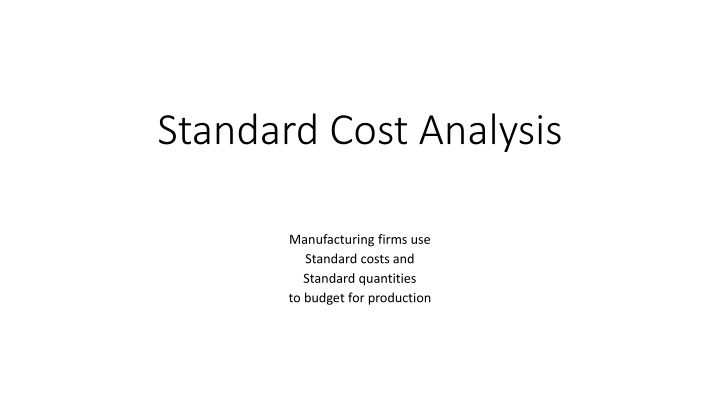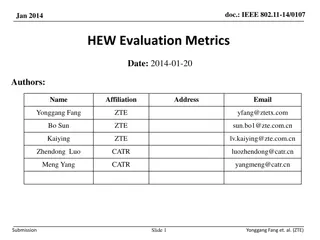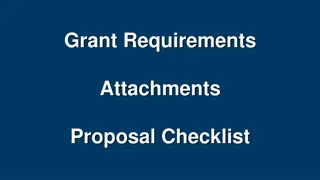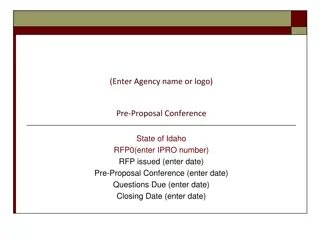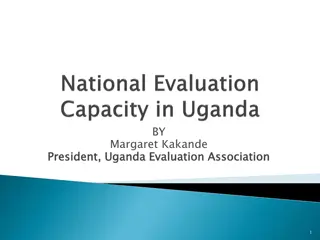Applied Research and Evaluation Pre-proposal Conference
"Join us for the Applied Research and Evaluation Pre-proposal Conference on June 13th, 2019 at 2:00 PM to learn about the requirements, timeline, and submission details. Explore opportunities to collaborate with the New York City Department of Youth and Community Development. Submit your proposals in person following the guidelines provided. Be prepared to contribute to MWBE participation goals for awarded agreements."
Download Presentation

Please find below an Image/Link to download the presentation.
The content on the website is provided AS IS for your information and personal use only. It may not be sold, licensed, or shared on other websites without obtaining consent from the author.If you encounter any issues during the download, it is possible that the publisher has removed the file from their server.
You are allowed to download the files provided on this website for personal or commercial use, subject to the condition that they are used lawfully. All files are the property of their respective owners.
The content on the website is provided AS IS for your information and personal use only. It may not be sold, licensed, or shared on other websites without obtaining consent from the author.
E N D
Presentation Transcript
Standard Cost Analysis Manufacturing firms use Standard costs and Standard quantities to budget for production
Standard Costs Standard Costs In the last chapter, we investigated flexible budget variances. These variances provide feedback concerning how well an organization performed in relation to its budget. The impact on profit of a change in the level of activity is captured in the overall activity variance. The revenue and spending variances indicate how well revenues and costs were controlled given the actual level of activity. In the case of many of the spending variances, we can get even more detail about how well costs were controlled using standard costs. For example, an unfavorable spending variance for supplies could be due to paying too much for the supplies or to using too many supplies, or some combination of the two. It would be useful to separate those two different effects, particularly if different people are responsible for purchasing the supplies and for using them.
Standard Costs Standard Costs Setting the Stage Setting the Stage A standard is a benchmark for measuring performance. Standards are also widely used in managerial accounting where they relate to the quantity and acquisition price of inputs used in manufacturing goods or providing services. Quantity standards specify how much of an input should be used to make a product or provide a service. Price standards specify how much should be paid for each unit of the input. If either the quantity or acquisition price of an input departs significantly from the standard, managers investigate the discrepancy to find the cause of the problem and eliminate it. A company will establish quantity and price standards for direct materials and direct labor.
An example of standard costs Standard Quantity Standard Price Cost per Unit Direct Materials Direct Labor Var Overhead 3 lb .50 hours .50 hours $ 4.00 22.00 1.75 $ $ 12.00 11.00 0.88 23.88
Setting Direct Labor Standards Setting Direct Labor Standards Direct labor quantity and price standards are usually expressed in terms of labor-hours or a labor rate. The standard hours per unit defines the amount of direct labor-hours that should be used to produce one unit of finished goods allowing for breaks, personal needs of employees, cleanup, and machine downtime. One approach used to determine this standard is for an industrial engineer to do a time and motion study, actually clocking the time required for each task. The standard rate per hour defines the company s expected direct labor wage rate per hour, including employment taxes and fringe benefits. This standard rate reflects the expected mix of workers, even though the actual hourly wage rates may vary somewhat from individual to individual due to differing skills or seniority.
Setting Direct Material Standards Setting Direct Material Standards The standard quantity per unit defines the amount of direct materials that should be used for each unit of finished product, including an allowance for normal inefficiencies, such as scrap and spoilage. One difference will be if the amount used in production is different from the amount purchased. Then, we will want to separate the calculations. The standard price per unit defines the price that should be paid for each unit of direct materials and it should reflect the final, delivered cost of those materials.
Manufacturing Overhead Manufacturing overhead uses a predetermined rate which is applied to a job based upon which job activity drives the overhead. Typically, the driver is direct labor hours or machine hours. The predetermined rate is determined at the beginning of the accounting year. It is comprised of all projected overhead costs (both fixed and variable) divided by the projected volume of the driver (number of direct labor/machine hours). This process is usually done during the budget phase for the upcoming year. The predetermined rates helps to avoid fluctuations of costs by averaging out the effects of the overhead costs and allows for comparison of similar jobs completed in different time periods
Calculation of Predetermined Overhead Rate Predetermined Overhead Rate = Beginning of the Year Projected Fixed Overead plus (Beginning of the Year Projected Variable Overead times Total Allocation Base) Beginning of the Year Total Allocation Base Example: 140,000 plus (2.50 times 40,000 direct labor hours) 40,000 direct labor hours 140,000 plus 100,000 40,000 direct labor hours Equals $6 per hour
Capital Budgeting Decisions
Managers often consider decisions that involve an investment today in the hope of realizing future profits. Merck & Co. invests in medical research. Amazon.com makes an investment when it redesigns its website. All of these investments require spending money now to realize future net cash inflows. The term capital budgeting is used to describe how managers plan significant investments in projects that have long-term implications such as the purchase of new equipment or the introduction of new products. Most companies have many more potential projects than they can actually fund. Hence, managers must carefully select those projects that promise the greatest future return.
Typical Capital Budgeting Decisions -- Any decision that involves a cash outlay now to obtain a future return Capital budgeting decisions fall into two broad categories screening decisions and preference decisions. Screening decisions relate to whether a proposed project is acceptable whether it passes a preset hurdle. For example, a company may have a policy of accepting projects only if they provide a return of at least 20 percent on the investment. Preference decisions, by contrast, these decisions relate to selecting from among several acceptable alternatives. To illustrate, a company may be considering several different machines to replace an existing machine on the assembly line. 1.Cost reduction decisions. Should new equipment be purchased to reduce costs? 2.Expansion decisions. Should a new plant, warehouse, or other facility be acquired to increase capacity and sales? 3.Equipment selection decisions. Which of several available machines should be purchased? 4.Lease or buy decisions. Should new equipment be leased or purchased? 5.Equipment replacement Should old equipment be replaced now or later? decisions.
This chapter discusses four methods for making capital budgeting decisions 1.Payback method, 2.Net present value method, 3.Internal rate of return method, (These three focus on the investment s rate of return.) 4. Simple rate of return method. (Focuses on incremental net income).
Investment internal rate of return concepts: Payback method, Net present value method, and Internal rate of return method Typical Cash Outflows They often require an immediate cash outflow in the form of an initial investment in equipment, other assets, and installation costs, and any salvage would be a reduction of outflows. Some projects require a company to expand its working capital. Working capital--current assets less current liabilities. When a company takes on a new project, the balances in the current asset accounts often increase more cash needed in registers, more inventory needed. These additional working capital needs are treated as part of the initial investment in a project. Many projects require periodic outlays for repairs and maintenance and additional operating costs. Typical Cash Inflows A project will normally increase revenues or reduce costs. Either way, the amount involved should be treated as a cash inflow for capital budgeting purposes. A reduction in costs is equivalent to an increase in revenues. Cash inflows are also frequently realized from salvage Any working capital that was tied up in the project can be released for use elsewhere at the end of the project. Working capital is released, for example, when a company sells inventory or collects its accounts receivable.
Investment internal rate of return concepts: Payback method, Net present value method, and Internal rate of return method The time value of money recognizes that a dollar today is worth more than a dollar a year from now if for no other reason than you could put the dollar in a bank today and have more than a dollar a year from now. Beyond defining a capital project s cash outflows and inflows, it is also important to consider when those cash flows occur. For example, if someone offered to give you $1,000 dollars today that you could save toward your eventual retirement or a year from now that you could save toward your future retirement Likely, you would choose to receive $1,000 today because you could invest it and have more than $1,000 dollars a year from now. Because of the time value of money, capital investments that promise earlier cash flows are preferable to those that promise later cash flows. Although the payback method focuses on cash flows, it does not recognize the time value of money. In other words, it treats a dollar received today as being of equal value to a dollar received at any point in the future. Conversely, the net present value and internal rate of return methods not only focus on cash flows, but they also recognize the time value of those cash flows. These two methods use a technique called discounting cash flows to translate the value of future cash flows to their present value. This simple example illustrates an important capital budgeting concept known as the time value of money.
The Payback Method - Focuses on the payback period. The payback period is the length of time that it takes for a project to recover its initial cost from the net cash inflows that it generates-- the time that it takes for an investment to pay for itself. York Company needs a new milling machine. The company is considering two machines: machine A and machine B. Machine A costs $15,000, has a useful life of ten years, and will reduce operating costs by $5,000 per year. The basic premise of the payback method is that the more quickly the cost of an investment can be recovered, the more desirable is the investment. Machine B costs only $12,000, will also reduce operating costs by $5,000 per year, but has a useful life of only five years. The payback period is expressed in years. When the annual net cash inflow is the same every year, the following formula can be used to compute the payback period: York Company should purchase Machine B because it has a shorter payback period than Machine A.
The Payback Method - Focuses on the payback period. Evaluation of the Payback Method York Company needs a new milling machine. The company is considering two machines: machine A and machine B. The payback method is not a true measure of the profitability of an investment. Rather, it simply tells a manager how many years are required to recover the original investment. Machine A costs $15,000, has a useful life of ten years, and will reduce operating costs by $5,000 per year. Unfortunately, a shorter payback period does not always mean that one investment is more desirable than another. Machine B costs only $12,000, will also reduce operating costs by $5,000 per year, but has a useful life of only five years. Machine B has a shorter payback period than machine A, but it has a useful life of only 5 years rather than 10 years for machine A. Machine B would have to be purchased twice once immediately and then again after the fifth year to provide the same service as just one machine A. Under these circumstances, machine A would probably be a better investment than machine B, even though machine B has a shorter payback period. York Company should purchase Machine B because it has a shorter payback period than Machine A. Unfortunately, the payback method ignores all cash flows that occur after the payback period.
The Payback Method - Focuses on the payback period. Under certain conditions the payback method can be very useful. For one thing, it can help identify which investment proposals are in the ballpark. That is, it can be used as a screening tool to help answer the question, Should I consider this proposal further? If a proposal doesn t provide a payback within some specified period, then there may be no need to consider it further. In addition, the payback period is often important to new companies that are cash poor. When a company is cash poor, a project with a short payback period but a low rate of return might be preferred over another project with a high rate of return but a long payback period. The reason is that the company may simply need a faster return of its cash investment. And finally, the payback method is sometimes used and most appropriate in industries where products become obsolete very rapidly such as consumer electronics. Because products may last only a year or two, the payback period on investments must be very short.
The Net Present Value Method The net present value method compares the present value of a project s cash inflows to the present value of its cash outflows. Harper Company is contemplating buying a new machine that will cost $50,000 and last for five years. The new machine will enable the company to reduce its labor costs by $18,000 per year. At the end of the five-year period, the company will sell the machine for its salvage value of $5,000. Harper Company requires a minimum pretax return of 18% on all investment projects. The difference between the present value of these cash flows, called the net present value, determines whether a project is an acceptable investment. Managers usually make two important assumptions. Should the machine be purchased? Harper Company must determine whether a cash investment now of $50,000 can be justified if it will result in an $18,000 cost reduction in each of the next five years. They assume that all cash flows other than the initial investment occur at the end of periods. This assumption is somewhat unrealistic because cash flows typically occur throughout a period rather than just at its end; however, it simplifies the computations considerably. The answer may seem obvious given that the total cost savings is $90,000 ($18,000 per year 5 years); however, the company can earn an 18 percent return by investing its money elsewhere. They assume that all cash inflows generated by an investment project are reinvested at a rate of return equal to the rate used to discount the future cash flows, also known as the discount rate. (If this condition is not met, the net present value computations will not be accurate.) It is not enough that the annual cost reductions cover just the original cost of the machine; they must also yield a return of at least 18% or the company would be better off investing the money elsewhere.
The Net Present Value Method Harper Company is contemplating buying a new machine that will cost $50,000 and last for five years. The stream of annual $18,000 cost savings and the machine s salvage value of $5,000 should be discounted to their present values and then compared to the cost of the new machine. The new machine will enable the company to reduce its labor costs by $18,000 per year. At the end of the five-year period, the company will sell the machine for its salvage value of $5,000. Harper Company requires a minimum pretax return of 18% on all investment projects. Should the machine be purchased? Harper Company must determine whether a cash investment now of $50,000 can be justified if it will result in an $18,000 cost reduction in each of the next five years. The answer may seem obvious given that the total cost savings is $90,000 ($18,000 per year 5 years); however, the company can earn an 18 percent return by investing its money elsewhere. It is not enough that the annual cost reductions cover just the original cost of the machine; they must also yield a return of at least 18% or the company would be better off investing the money elsewhere.
The Net Present Value Method The stream of annual $18,000 cost savings and the machine s salvage value of $5,000 should be discounted to their present values and then compared to the cost of the new machine. The Concept of Present Value and Discounting Remember, a dollar received today is more valuable than a dollar received a year from now for the simple reason that if you have a dollar today, you can put it in the bank and have more than a dollar a year from now. Because dollars today are worth more than dollars in the future, cash flows that are received at different times must be valued differently. The Mathematics of Interest If a bank pays 5% interest, then a deposit of $100 today will be worth $105 one year from now. This can be expressed as follows: F1 = the balance at the end of one period, P = the amount invested now, and r = the rate of interest per period. $100 is deposited in a savings account that earns 5% interest, P = $100 and r = 0.05. Under these conditions, F1 = $105. The $100 present outlay is called the present value of the $105 amount to be received in one year. It is also known as the discounted value of the future $105 receipt. The $100 represents the value in present terms of $105 to be received a year from now when the interest rate is 5%.
The Net Present Value Method The Concept of Present Value and Discounting A dollar received today is more valuable than a dollar received a year from now for the simple reason that if you have a dollar today, you can put it in the bank and have more than a dollar a year from now. Because dollars today are worth more than dollars in the future, cash flows that are received at different times must be valued differently. The Mathematics of Interest If a bank pays 5% interest, then a deposit of $100 today will be worth $105 one year from now. This can be expressed as follows: F1 = the balance at the end of one period, P = the amount invested now, and r = the rate of interest per period. $100 is deposited in a savings account that earns 5% interest, P = $100 and r = 0.05. Under these conditions, F1 = $105. Computation of Present Value An investment can be viewed in two ways either in terms of its future value or in terms of its present value. We have seen from our computations above that if we know the present value of a sum (such as our $100 deposit), the future value can be computed. But what if the situation is reversed and we know the future value of some amount but we do not know its present value? The $100 present outlay is called the present value of the $105 amount to be received in one year. It is also known as the discounted value of the future $105 receipt. The $100 represents the value in present terms of $105 to be received a year from now when the interest rate is 5%.
The Net Present Value Method For example, assume that you are to receive $200 two years from now. You know that the future value of this sum is $200. But what is the sum s present value what is it worth right now? The present value of any sum to be received in the future can be computed by: The present value of a $200 amount to be received two years from now is $181.40 if the interest rate is 5%. In effect, $181.40 received right now is equivalent to $200 received two years from now. Computation of Present Value An investment can be viewed in two ways either in terms of its future value or in terms of its present value. We have seen from our computations above that if we know the present value of a sum (such as our $100 deposit), the future value can be computed. But what if the situation is reversed and we know the future value of some amount but we do not know its present value? The process of finding the present value of a future cash flow, which we have just completed, is called discounting. We have discounted the $200 to its present value of $181.40. The 5% interest we used to find this present value is called the discount rate. Discounting future sums to their present value is a common practice in business, particularly in capital budgeting decisions.
Interpreting a Projects Net Present Value Once a minimum rate of return for a project has been established: A company s cost of capital is usually regarded as its minimum required rate of return. The cost of capital is the average rate of return that the company must pay to its long-term creditors and its shareholders for the use of their funds. If a project s rate of return is less than the cost of capital, the company does not earn enough to compensate its creditors and shareholders. Therefore, any project with a rate of return less than the cost of capital should be rejected. The cost of capital serves as a screening device. When the cost of capital is used as the discount rate in net present value analysis, any project with a negative net present value does not cover the company s cost of capital and should be discarded as unacceptable.
Internal Rate of Return Internal Rate of Return To compute the internal rate of return of the new mower, we must find the discount rate that will result in a zero net present value. The internal rate of return is the rate of return of an investment project over its useful life. The internal rate of return is computed by finding the discount rate that equates the present value of a project s cash outflows with the present value of its cash inflows. In other words, the internal rate of return is the discount rate that results in a net present value of zero. Glendale School District is considering the purchase of a large tractor-pulled lawn mower. At present, the lawn is mowed using a small hand-pushed gas mower. The large, tractor-pulled mower will cost $16,950 and will have a useful life of 10 years. It will have a negligible scrap value, which can be ignored. The tractor-pulled mower would do the job faster than the old mower, resulting in labor savings of $3,000 per year. The simplest and most direct approach when the net cash inflow is the same every year is to divide the investment in the project by the expected annual net cash inflow. This computation yields a factor from which the internal rate of return can be determined. This project yields a 12% return.
Simple Rate of Return Focuses on Net Operating Income not Rate of Return Annual incremental net operating income generated by a project is divided by the initial investment in the project. The annual incremental net operating income should be reduced by the annual depreciation and any salvage value realized from the sale of old equipment. Brigham Tea, Inc., is a processor of low-acid tea. The company is contemplating purchasing equipment for an additional processing line that would increase revenues by $90,000 per year. Incremental cash operating expenses would be $40,000 per year. The equipment would cost $180,000 and have a nine-year life with no salvage value.
Simple Rate of Return The simple rate of return suffers from two important limitations. More importantly, you need to understand how the simple rate of return method influences the behavior of investment center managers who are evaluated and rewarded based on their return on investment (ROI). First, it focuses on accounting net operating income rather than cash flows. Thus, if a project does not have constant incremental revenues and expenses over its useful life, the simple rate of return will fluctuate from year to year, thereby possibly causing the same project to appear desirable in some years and undesirable in others. For example, assume the following three facts. First, assume you are an investment center manager whose pay raises are based solely on ROI. Second, assume that last year your division had an ROI of 20 percent. Third, assume your division has the chance to pursue a capital budgeting project that will have a positive net present value and a simple rate of return of 17 percent. Second, the simple rate of return method does not involve discounting cash flows. It considers a dollar received 10 years from now to be as valuable as a dollar received today. Given these three assumptions, would you choose to accept this project or reject it? Although the company would want you to accept it because of its positive net present value, you would probably choose to reject it because the simple rate of return of 17 percent is less than your prior year s ROI of 20 percent. Some companies use the simple rate of return to evaluate capital investment proposals. This basic example illustrates how a project s simple rate of return can influence the decisions made by investment center managers. Therefore, you should be familiar with this approach so you can properly critique it if you encounter it in practice. It also highlights an important challenge faced by organizations, namely designing performance measurement systems that align employee actions with organizational goals.
Preference DecisionsThe Ranking of Investment Projects When considering investment opportunities, managers must make two types of decisions screening decisions and preference decisions. Screening decisions, which come first, pertain to whether or not a proposed investment is acceptable. Internal Rate of Return Method When using the internal rate of return method to rank competing investment projects, the preference rule is: Preference decisions come after screening decisions and attempt to answer the following question: How do the remaining investment proposals, all of which have been screened and provide an acceptable rate of return, rank in terms of preference? The higher the internal rate of return, the more desirable the project. That is, which one(s) would be best for the company to accept? An investment project with an internal rate of return of 18 percent usually is considered preferable to another project that has a return of only 15 percent. Internal rate of return is widely used to rank projects. Either the internal rate of return method or the net present value method can be used in making preference decisions. However, as discussed earlier, if the two methods are in conflict, it is best to use the net present value method, which is more reliable.
Preference DecisionsThe Ranking of Investment Projects This fact can be highlighted by dividing the present value of each project s cash inflows by its investment required. Net Present Value Method The net present value of one project cannot be directly compared to the net present value of another project unless the initial investments are equal. The result, shown below in equation form, is called the profitability index. For example, assume that a company is considering two competing investments, as shown below: A B 6,000 5,000 1.2 Present value of cash flows (a) Investment required (b) Profitability index (a/b) 11,000 10,000 1.1 The higher the profitability index, the more desirable the project. Although each project has a net present value of $1,000, the projects are not equally desirable if the funds available for investment are limited. The profitability index is an application of the techniques for utilizing constrained resources where limited funds available for investment is the constraining resource. (The profitability index is similar to the contribution margin per unit of the constrained resource.) The project requiring an investment of only $5,000 is much more desirable than the project requiring an investment of $10,000. This fact can be highlighted by dividing the present value of each project s cash inflows by its investment required. The result, shown below in equation form, is called the profitability index.
Preference DecisionsThe Ranking of Investment Projects This fact can be highlighted by dividing the present value of each project s cash inflows by its investment required. The result, shown below in equation form, is called the profitability index. A few details should be clarified with respect to the computation of the profitability index. The Investmentrequired refers to any cash outflows that occur at the beginning of the project, reduced by any salvage value recovered from the sale of old equipment. A B 6,000 5,000 1.2 Present value of cash flows (a) Investment required (b) Profitability index (a/b) 11,000 10,000 1.1 The Investmentrequired also includes any investment in working capital that the project may need. The higher the profitability index, the more desirable the project. The profitability index is an application of the techniques for utilizing constrained resources where limited funds available for investment is the constraining resource. (The profitability index is similar to the contribution margin per unit of the constrained resource.)
